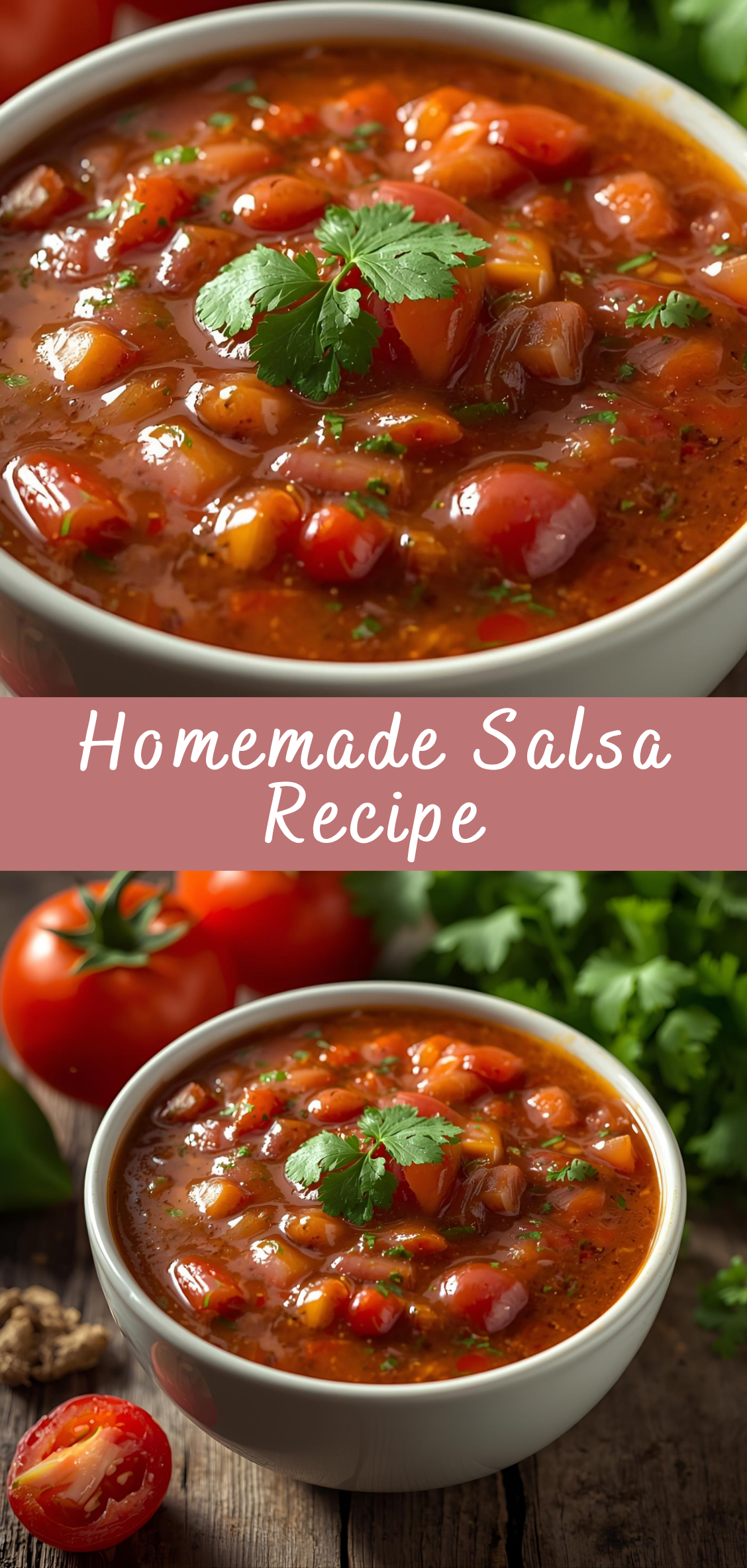The Ultimate Homemade Salsa Recipe: Fresh, Flavorful, and Made From Scratch
Few things in the culinary world strike the perfect balance between simplicity and flavor quite like a great salsa. Whether you’re dipping tortilla chips during a casual get-together, spooning it over tacos on a Tuesday night, or using it as a marinade for grilled meats, salsa is one of those universally loved condiments that instantly enhances almost any dish it touches. It’s vibrant, fresh, zesty—and when made at home, it’s even better.

Homemade salsa isn’t just about tossing together tomatoes and onions; it’s about capturing the essence of fresh ingredients and transforming them into a bold, balanced, and deeply satisfying experience. Unlike many store-bought versions that are loaded with preservatives, excess sodium, and artificial flavors, a good homemade salsa is made with real, whole ingredients—and the difference is unmistakable. Each bite bursts with garden-fresh tomatoes, the heat of chilies, the bite of raw onion, and the brightness of lime and cilantro.
But there’s more to salsa than just flavor. It’s also incredibly versatile. Once you learn the basics, you can experiment endlessly—roasting your ingredients for a smokier taste, switching up peppers for more or less heat, or even adding fruits like mango or pineapple for a sweet-savory twist. From chunky pico de gallo to smooth restaurant-style blends, the world of salsa is rich with possibility.
In this in-depth guide, we’ll walk you through everything you need to know to make the perfect salsa at home—from choosing the right ingredients and tools, to mastering various preparation techniques and customizing your flavor profile. We’ll also explore salsa’s history, regional variations, storage methods, and creative uses beyond the chip bowl. Whether you’re a beginner in the kitchen or a seasoned home cook, you’ll walk away with the knowledge and confidence to make salsa that suits your taste and impresses your guests.
So, grab your cutting board, fire up your blender or food processor, and get ready to explore the art of making salsa from scratch. This is more than just a recipe—it’s your passport to bold flavor, fresh ingredients, and the satisfaction of creating something truly delicious with your own hands.
Step-by-Step Instructions: How to Make Homemade Salsa
Making salsa at home can be as quick as 10 minutes or as involved as roasting and simmering ingredients to deepen flavor. This guide covers both the classic fresh salsa method and optional roasting techniques for a richer taste. Follow along, and you’ll master the art of homemade salsa in no time.
Step 1: Gather Your Ingredients
Start by collecting all your fresh produce and pantry staples. Using high-quality, fresh ingredients will elevate the flavor of your salsa more than any other factor.
Basic Ingredients for a Classic Tomato Salsa (Yields about 3 cups):
-
5–6 ripe Roma tomatoes or 4 large vine-ripened tomatoes
-
1 small white or yellow onion, roughly chopped
-
2–3 cloves garlic (peeled)
-
1–2 jalapeño peppers (seeded for mild, unseeded for more heat)
-
1/2 cup fresh cilantro leaves (stems removed)
-
Juice of 1 lime (about 2 tablespoons)
-
Salt to taste (start with 1/2 teaspoon)
-
Optional: 1/2 teaspoon ground cumin
-
Optional: 1–2 teaspoons white vinegar or apple cider vinegar for tang
Optional Add-ins:
-
1–2 chipotle peppers in adobo sauce (for smoky depth)
-
1/2 teaspoon sugar (balances acidity in canned tomatoes)
-
Roasted red peppers or charred tomatillos
-
Diced avocado (added after blending)
Step 2: Decide on Style — Fresh vs. Roasted
There are two main styles of salsa:
1. Fresh Salsa (Salsa Cruda or Pico de Gallo-style blend):
-
Uses raw, fresh ingredients
-
Bright, crisp, and herbaceous flavor
-
Perfect for quick dips, topping tacos, or scooping with chips
2. Roasted Salsa (Salsa Roja Asada):
-
Tomatoes, onions, garlic, and peppers are roasted before blending
-
Deeper, more complex and slightly smoky flavor
-
Excellent for grilling, spooning on meats, or using in enchiladas
Choose your style before moving on. We’ll cover instructions for both, beginning with the fresh version.
FRESH SALSA METHOD (No Cooking Required)
Step 3: Prep the Vegetables
Start by washing and chopping the vegetables.
Instructions:
-
Tomatoes: Core and roughly chop the tomatoes. If you want a less watery salsa, remove the seeds and pulpy interior before chopping.
-
Onion: Peel and roughly chop the onion. A mild white or yellow onion works best.
-
Garlic: Peel the garlic cloves. No need to chop them—they’ll blend easily.
-
Jalapeños: Cut off the stem and slice in half. Remove seeds for a milder salsa; leave some in for more heat.
-
Cilantro: Wash thoroughly. Use mostly the leaves, though soft stems are fine.
-
Lime: Roll the lime on the counter, then juice it.
-
Optional Ingredients: If using canned chipotles or vinegar, have those ready too.
Step 4: Blend or Process the Ingredients
Now it’s time to mix everything together. You can use a food processor, blender, or even a mortar and pestle (molcajete) if you want a traditional texture.
Instructions:
-
Add the tomatoes, onion, garlic, jalapeño, and cilantro to the blender or food processor.
-
Pulse in short bursts if you want a chunky texture, or blend longer for a smooth consistency.
-
Add lime juice, salt, and optional seasonings (cumin, chipotle, vinegar).
-
Taste, then adjust seasoning if needed. Add more salt or lime juice to brighten the flavor, or a pinch of sugar to cut acidity.
Step 5: Chill and Let Flavors Develop (Optional but Recommended)
Though fresh salsa can be eaten immediately, the flavor improves after resting.
Instructions:
-
Transfer the salsa to an airtight container or bowl.
-
Cover and refrigerate for at least 30 minutes (up to 24 hours).
-
Stir before serving. If liquid separates, just mix it again.
ROASTED SALSA METHOD (For a Deeper, Smokier Flavor)
Step 3: Roast the Vegetables
Roasting your ingredients brings out natural sweetness, softens bitterness, and adds a lovely charred, smoky flavor.
Instructions:
-
Preheat your oven to 450°F (230°C) or heat a dry skillet or grill.
-
Cut tomatoes in half, leaving the skin on.
-
Peel and quarter the onion.
-
Leave garlic cloves in their skin to prevent burning.
-
Place tomatoes, onion, whole jalapeños, and garlic on a baking sheet or cast-iron pan.
-
Roast for 15–20 minutes, flipping halfway through, until vegetables are soft and charred in spots.
Alternative Methods:
-
Roast directly over a gas flame for a smoky, blistered finish.
-
Use a broiler for a faster char.
Step 4: Cool Slightly and Blend
After roasting:
-
Let the vegetables cool for 5–10 minutes.
-
Peel the garlic and remove tomato skins if desired (for a smoother texture).
-
Add all roasted items to a blender or food processor.
-
Include cilantro, lime juice, salt, and optional ingredients like chipotle or cumin.
-
Pulse or blend to desired texture.
-
Taste and adjust seasoning.
Step 5: Simmer (Optional for Even Deeper Flavor)
If you prefer a cooked salsa with a more concentrated flavor:
-
Pour blended salsa into a saucepan.
-
Simmer on low heat for 10–15 minutes, stirring occasionally.
-
Let cool and store.
Step 6: Taste and Adjust
Now comes the most important part: making the salsa your own.
Tasting Tips:
-
Too bland? Add more salt or lime juice.
-
Too spicy? Add a chopped tomato or a little sugar.
-
Too acidic? Try a pinch of sugar or roast your ingredients next time.
-
Lacking depth? Add a chipotle pepper or a dash of cumin.
The goal is balance—acid, heat, salt, and freshness all working together.
Step 7: Serve
Once your salsa is blended, chilled (if desired), and seasoned to perfection, it’s ready to go.
Serving Ideas:
-
As a dip with tortilla chips
-
Over tacos, burritos, nachos, or enchiladas
-
As a topping for grilled chicken, fish, or steak
-
Stirred into rice or beans for extra flavor
-
Mixed with avocado for a quick guacamole
Homemade Salsa Recipe
Few things in the culinary world strike the perfect balance between simplicity and flavor quite like a great salsa. Whether you’re dipping tortilla chips during a casual get-together, spooning it over tacos on a Tuesday night, or using it as a marinade for grilled meats, salsa is one of those universally loved condiments that instantly enhances almost any dish it touches. It’s vibrant, fresh, zesty—and when made at home, it’s even better.
Ingredients
- 4–5 ripe Roma tomatoes (or 1 can [14.5 oz] diced tomatoes, drained)
- 1 small onion, chopped
- 1–2 cloves garlic, minced
- 1 jalapeño, seeded and chopped (leave seeds in for more heat)
- 1/2 cup fresh cilantro leaves
- Juice of 1 lime
- Salt to taste (start with 1/2 tsp)
- Optional: 1/2 tsp ground cumin or a pinch of sugar if tomatoes are too acidic
Instructions
- Prepare ingredients:
Roughly chop tomatoes, onion, jalapeño, and garlic. - Blend:
Add all ingredients to a blender or food processor. Pulse until desired consistency is reached — chunky or smooth. - Taste and adjust:
Taste and adjust salt, lime, or jalapeño for more spice. You can add a pinch of sugar if it's too acidic. - Chill (optional):
For best flavor, refrigerate for at least 30 minutes before serving. - Serve:
Serve with tortilla chips, tacos, grilled meats, or as a topping for taco pasta!
Notes
- Tomatoes: Fresh tomatoes are best in summer. In winter, use canned tomatoes for better flavor.
- Make it smoky: Add a chipotle pepper in adobo sauce for a smoky kick.
- Mild version: Use half a jalapeño and remove all seeds/membrane.
- Chunky salsa tip: Use a knife to finely chop ingredients instead of blending.

